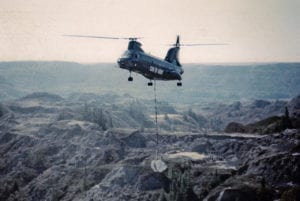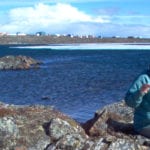The loud swishing noise of two helicopter blades filled the air as it approached the field site. The pilot descended to a dozen meters off the ground, and Dr. Richard Fox, head of the University of Alberta’s vertebrate paleontology department, immediately grabbed the longline to attach the precious cargo for the sling. It was September 19, 1967, and the full plaster cast of a dinosaur specimen had just been airlifted from an outcrop in Dry Island Buffalo Jump Provincial Park, Alberta.

Specimen UALVP 16182 being airlifted from outcrop, 1967. (Photo | Allan Lindoe)
That day, the field crew from the University of Alberta celebrated two firsts. They had collected specimen UALVP 16182, the first near-complete dinosaur skeleton found in Alberta in over a decade and had successfully organized the first helicopter airlift of a fossilized dinosaur in Canada.
With such an auspicious beginning, it’s no wonder that UALVP 16182 is one of the most important specimens at the University of Alberta. In a new study published in the Canadian Journal of Earth Sciences, researchers have also been able to use the specimen as a diagnostic model for distinguishing dinosaur lineages.
UALVP 16182 is a type of theropod (meaning beast foot) that resembles ostriches with long necks and small heads. The specimen is further classified as a type of ornithomimid dinosaur, which was a relatively small, fast creature with long slender legs that adapted to the warm temperate forests typical of the region 70 million years ago.
The fossils collected by Dr. Fox in 1967 include both the femur and tibia, which set it apart from other specimens. Additionally, the specimen is also the only one in the world for which an almost complete manus, or clawed hand, is preserved.
“Our primary goal was to describe this excellent specimen”, wrote Ian Macdonald, the study author now working at the Royal Tyrrell Museum in Alberta.
Macdonald and co-authors also wondered if the specimen, identified as the species Dromiceiomimus, was in fact its own distinct species or if the specimen belonged to Ornithomimus, a close relative. Professional opinion had tended toward the latter, but Macdonald wondered if new information gleaned from UALVP 16182 could better inform taxonomic classification.
“The quality of its preservation meant that we could ask some interesting questions,” he wrote. “Could the ratio of tibia length to femur length be used to distinguish this dinosaur from closely related forms? What other features of the skeleton were associated with this limb ratio?”
The differences between dinosaur specimens are subtle and, importantly, depend on the quality of the fossil bones extracted from outcrop. With UALVP 16182 being an exceptional specimen, the authors are confident that the ratio of tibia length to femur length in such well-preserved specimens can be used as a diagnostic feature when considered together with other significant differences in morphology.
“In our study, we propose that the two groups of dinosaurs previously classified as a single one are distinct,” concluded Macdonald. Excited by the original discovery, experts continue their hunt for fossil dinosaurs in Dry Island Buffalo Jump Provincial Park and other parts of southern Alberta. “It’s clear that additional fieldwork is needed that will reveal more fossils to test our conclusions,” wrote Macdonald.

Illustration of Dromiceiomimus (Photo | Eleanor Kish, © Canadian Museum of Nature)
Read the full paper: Description of a partial Dromiceiomimus (Dinosauria: Theropoda) skeleton with comments on the validity of the genus in the Canadian Journal of Earth Sciences.




